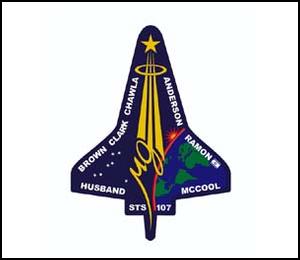
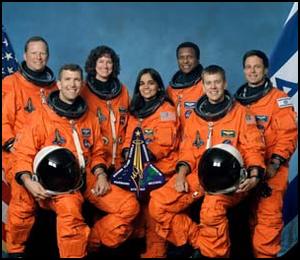
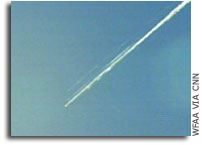
 |
 |
 |
Troisième semaine suivant
la destruction de Columbia :
• 15 février
: Ce que nous dit la NASA (en anglais)
• 18
février 2003 : Ce que nous dit la NASA (en
anglais)
• 18 février
: À la recherche de la «pierre philosophale»
• 20
février : Ce que la NASA nous dit (en anglais)
• 20
février : Ce que nous dit le CAIB (en anglais)
• 21
février : Cartes des derniers moments de Columbia
| Two additional
attitude control jets aboard Columbia fired after voice communication was
lost with the shuttle, an analysis of data from the subsequent seconds
indicates. Two other yaw control jets were known to have fired earlier,
but the analysis indicates that a third and fourth yaw jet also activated
in an attempt to maintain control of the vehicle.
One of five General Purpose Computers aboard Columbia also has been found among debris shipped to the Kennedy Space Center. The computer was badly damaged and its battery was missing. General Purpose Computers have no hard drives, so investigators held out little hope of extracting additional information. A shuttle main engine turbopump has been recovered not far from Ft. Polk in Louisiana. The pump was buried about 14 feet [4,0 m] below the ground's surface. As of early Saturday, the western boundary of the debris field remained just west of the Fort Worth, Texas, area. Still, teams continued to investigate reports of debris as far west as California. A search for debris is under way in the Sandia Mountains just east of Albuquerque, based on witness reports of sonic booms and impact noise in that area. |
| The search for
Columbia debris continues. Harold Gehman, chairman of the Columbia Accident
Investigation Board, thanked volunteers for their search efforts. "We still
need debris," he said, adding that collection is very important to the
board. He said about 4,000 pieces of debris are at Kennedy Space Center,
of which 2,600 have been identified, catalogued and are out on the reconstruction
hangar floor. An additional 10,000 pieces are headed toward Barksdale Air
Force Base at Shreveport, La., or KSC.
The Federal Emergency Management Agency (FEMA) said that 77 percent of sites in Texas and 99 percent of sites in Louisiana where Shuttle debris had been reported have been cleared. Board member Hallock said it appears that things were beginning to come off Columbia as it passed over California. He said that while it is important to understand what those pieces were, none has been found. As of early Tuesday, the western boundary of the debris field remained just west of the Fort Worth, Texas, area. The Forest Service-led Southern Area Incident Command "Blue Team" has set up a base camp in Nacogdoches, Texas. The debris search team has about 350 people and is expected to grow to 650 people during the next few days. Two other teams with about 700 members from NASA and more than a dozen other organizations are being deployed to Palestine and Hemphill, Texas. The number of searchers is expected to grow to more than 2,000 by the end of the week. |
À
l’occasion de leur deuxième conférence de presse, mardi 18
février, les représentants du Bureau d’enquête sur
l’accident de Columbia (CAIB) indiquent que l’orbiteur aurait commencé
à perdre des pièces au moment où il abordait les côtes
de la Californie, soit six minutes avant sa destruction. Ils soupçonnent
que ces premiers signes de bris pourraient être liés aux problèmes
constatés sur l’aile gauche de l’orbiteur, peut-être une fracture
du bord d’attaque de l’aile ou la rupture du scellant de la porte de la
soute du train d’atterrissage.
Néanmoins,
les enquêteurs demeurent dans l’incapacité d’entrevoir ce
qui pourrait être à l’origine de la tragédie. «Ce
qui me semble sauter aux yeux, c’est justement qu’aucune cause ne nous
sautent aux yeux!», de lancer Harold Gehman, le chef des enquêteurs.
«Nous ne sommes pas en présence d’une cause facile à
trouver, et ce sera un long travail [pour y parvenir].»
Parmi
les nombreuses pistes suivies, les enquêteurs s’intéressent
entre autres à l’impact au décollage d’un morceau du revêtement
du réservoir de la Navette sous Columbia. Ils considèrent
aussi un impact possible (mais non observé) d’un débris orbital
sur le bord d’attaque de l’aile. «S’il y a eu une fissure au niveau
de l’aile gauche, s’est-elle produite depuis l’intérieur de Columbia
ou a-t-elle été provoquée par quelque chose d’extérieur?»,
s’est questionné l’un des enquêteurs.
Harold
Gehman a par ailleurs rapporté qu’à ce jour, 3656 pièces
de Columbia ont été rapatriées à Cape Canaveral
alors que dix mille autres sont en route depuis le Texas et la Louisiane.
Cela ne représente toutefois que quelques tonnes, soit une fraction
de l’orbiteur qui pesait une centaine de tonnes.
Les
enquêteurs placent actuellement beaucoup d’espoir dans la récupération
de pièces qui se seraient détachées de Columbia lorsque
celui-ci traversait l’Ouest américain. Or, rien n’a été
trouvé à l’Ouest de Fort Worth, au Texas. Par conséquent,
la NASA vient de lancer de nouveaux appels pressants auprès de tous
les témoins du passage de l'orbiteur dans le ciel de la Californie,
de l’Arizona et du Nevada, en leur demandant de lui faire parvenir toute
photo ou film pris à cette occasion.
Columbia
se trouvait alors à quelques 80 kilomètres d’altitude et
filait à plus de vingt fois la vitesse du son. Conséquemment,
les fragments qui auraient pu s’en détacher ont probablement brûlés
telles des météorites. «Si ces petits fragments ne
se sont pas consumés avant d’atteindre le sol, relate tout de même
l’un des enquêteurs, ils se sont alors dispersés sur un vaste
territoire peu peuplé du Sud-ouest, notamment dans les montagnes
du Sud de la Californie et dans le Grand Canyon.»
Énormément
d’efforts sont mis en œuvre pour tenter de localiser des sites où
ces pièces auraient pu tomber. Dans un premier temps, à partir
des photos et des films montrant des fragments lumineux émanant
de Columbia, les spécialistes tentent de déterminer la trajectoires
que ceux-ci auraient pu suivre. Ensuite, ils utilisent les informations
recueillies par divers systèmes radar et de repérage (notamment
ceux de la Défense, des services aéroportuaires et météorologiques)
dans l’espoir de repérer la chute de certains fragments. Finalement,
le cas échéant, des équipes sont dépêchées
dans des lieux où on a quelque espoir de trouver quelque chose.
«Pour
sûr qu’il serait extrêmement important de déterminer
qu’elles ont été les pièces qui se sont détachées
de Columbia, particulièrement les premières», relate
l’un des enquêteurs avant d’ajouter avec un brin de pessimisme qu’il
s’agit de fouiller un territoire vaste et tortueux.
Parallèlement,
les recherches se poursuivent au Texas et en Louisiane afin de ramasser
le plus rapidement possible tous les débris manquants. De nouvelles
équipes de recherche, formées non plus de volontaires mais
de personnels provenant de diverses agences gouvernementales, sont maintenant
à pied d’œuvre. Les responsables des fouilles ressentent une certaine
urgence puisque d’ici quelques semaines, la végétation se
mettra à croître avec la venue du printemps.
.
| Investigators
are searching the area of Caliente, Nevada, for what could be a piece of
Space Shuttle Columbia debris believed to have been tracked by air traffic
control radar after it was shed early in the spacecraft's descent over
California and Nevada Feb. 1.
Video imagery of Columbia's entry provided to NASA was analyzed by imagery, trajectory and ballistics experts. The results of that analysis were then provided to National Transportation Safety Board officials who reviewed air traffic control radar imagery in that area during the time of Columbia's descent. The review resulted in what is believed to be a significant radar track of a piece of debris as it fell to Earth. As a result, a search of the Caliente area near the Nevada-Utah border is under way using Civil Air Patrol assets. A search using additional means also may be forthcoming. Similar work to narrow the possible locations of other debris believed to have been shed by Columbia above the U.S. Southwest continues, although no other areas have yet been identified for further investigation. About 25,000 pounds [11,3 tons] of Columbia debris is now at Kennedy Space Center in Florida. That total is about 11 percent of the orbiter's weight as it descended from orbit. About 5,600 items from the spacecraft currently are at KSC. The search for Columbia debris continues in Texas and Louisiana. So far, no confirmed Shuttle debris has been found west of Granbury, Texas, near Fort Worth. The Forest Service says more than 2,100 searchers should be in the field by Friday. They'll be a part of more than 100 teams based in Corsicana, Nacogdoches, Hemphill and Palestine, Texas. Bad weather hampered the search on Thursday. The search is being intensified to beat the area's spring bloom, which would make debris harder to find. NASA's position is still that there is no favorite theory about the cause of the Columbia accident. |
| The Columbia
Accident Investigation Board (CAIB) Advanced Sightings Team is working
to pinpoint the location of hardware that may have separated from the Space
Shuttle Columbia early in its final path over the western United States.
The team is bringing together data from the National Aeronautics and Space
Administration (NASA), the public, Department of Defense (DOD), Department
of Energy (DOE), the National Oceanic and Atmospheric Administration (NOAA),
the United States Geologic Survey (USGS) and all other sources of valuable
information that become available. The collaboration of all these organizations
has been outstanding. The team is piecing together the information from
these sources to learn as much as possible about anomalous conditions during
the entry of Columbia.
This team is analyzing video footage turned in by space flight enthusiasts and other sources of information to document exactly when these events occurred. The earliest shedding of Shuttle hardware may well have been documented by videos taken near the California coast. The team identifies anomalous events from the video data and correlates them to the entry timeline. Analysts calculate the exact time and angles of the observation by determining exactly where the videos were taken from and by identifying planets or star fields in the background. The team calculates trajectories to predict probabilities of where the debris may have fallen to Earth by estimating properties of possible debris from the video and incorporating known atmospheric and wind data. Radar data is then retrieved and investigated to search for specific signatures. This process serves to drastically reduce the area that must be searched. The Advanced Sightings Team is making significant progress in accurately characterizing possible debris events. They are in the process of making the subsequent calculations and taking the next steps. The most western find is still not far from Fort Worth, Texas. Using this process and other possible means, we hope debris discovered farther west would help to unravel the mystery of why this tragedy occurred. |
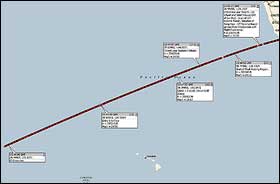 |
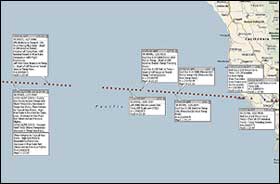 |
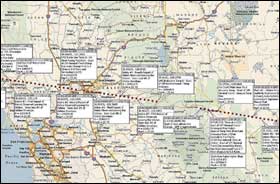 |
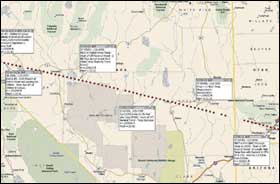 |
| Pacifique | Pacifique-Californie | Californie | Nevada |
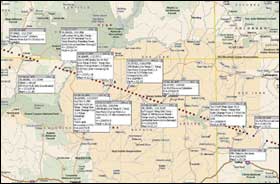 |
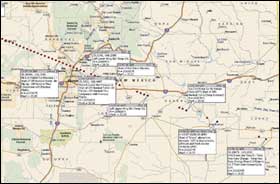 |
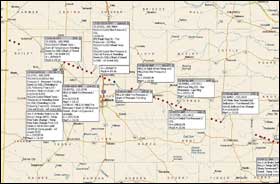 |
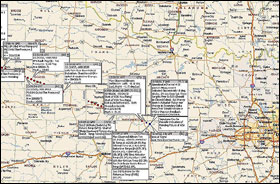 |
| Arizona | Nouveau-Mexique | N.-Mexique/Texas | Tezas |
| Mission STS 107 | Semaine 1 | Semaine 2 | Semaine 3 | Semaine 3 | Semaine 5 |